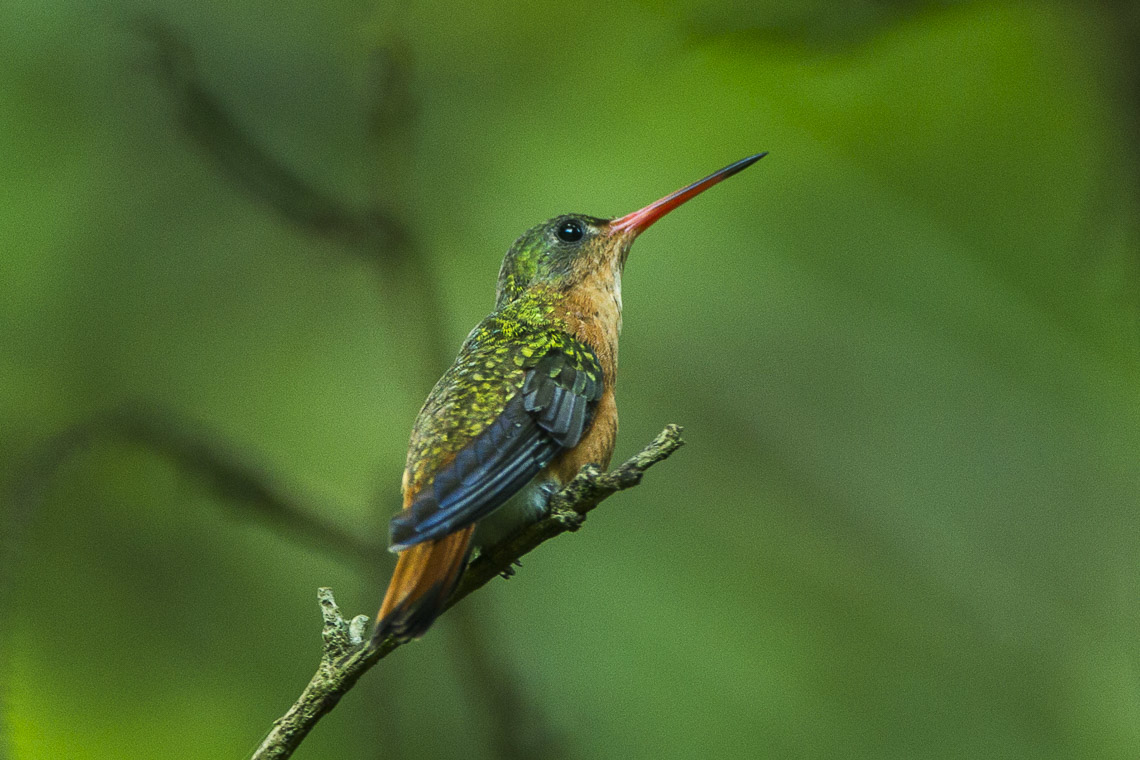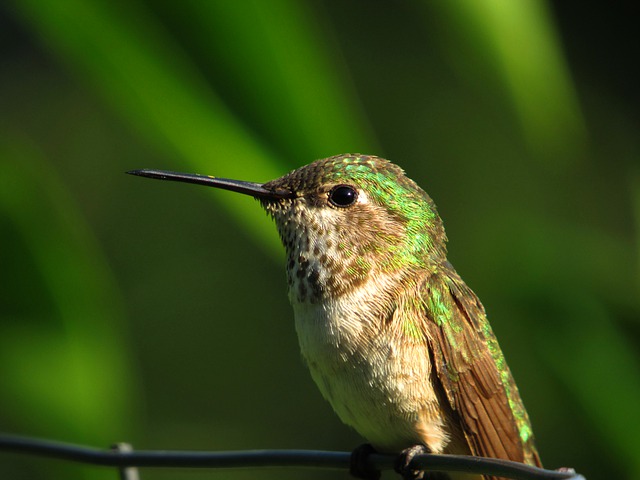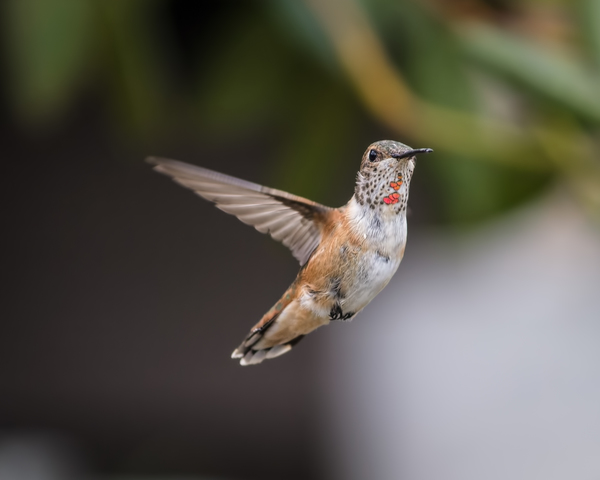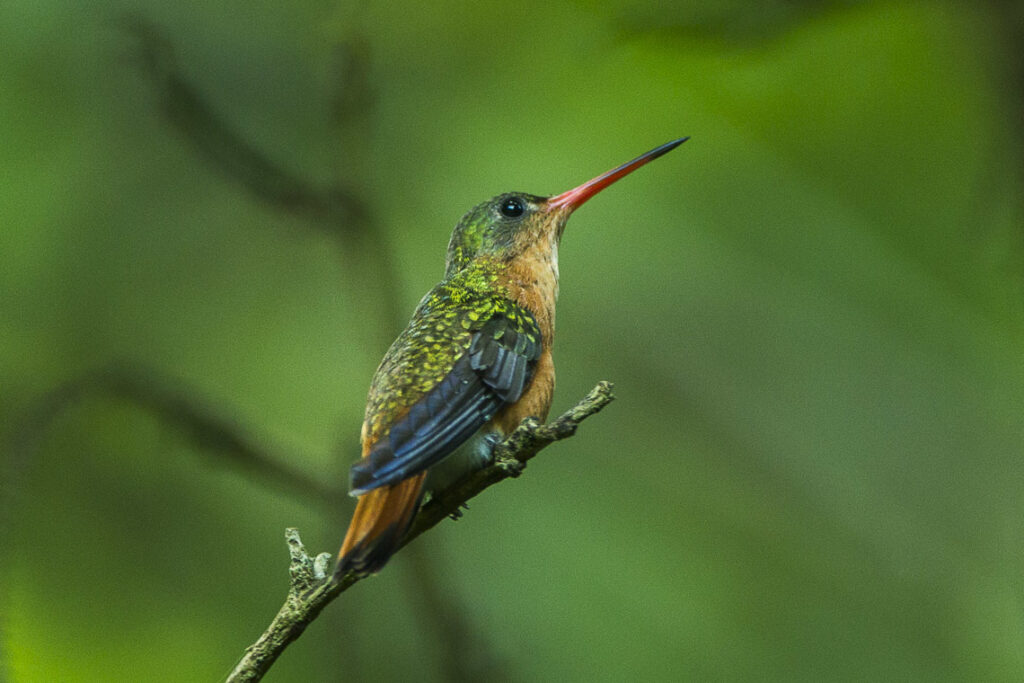Hummingbirds are one of nature’s most fascinating creatures, renowned for their dazzling iridescence and remarkable ability to hover in mid-air.
Among these captivating birds, the red hummingbirds of North America stand out as particularly eye-catching and unique.
With their brilliant plumage and high-energy lifestyles, these avian wonders capture the hearts and minds of bird enthusiasts and casual observers alike.
In this article, we’ll take a closer look at the seven types of red hummingbirds found in North America, each one distinct in its own way and sure to inspire wonder and awe in all who behold them.
So, grab your binoculars and get ready for a journey through the world of these magnificent birds!
| Image | |
|---|---|
 | Cinnamon Hummingbird |
 | Broad-Tailed Hummingbird |
 | Ruby-Throated Hummingbird |
 | Calliope Hummingbird |
 | Rufous Hummingbird |
 | Anna's Hummingbird |
 | Allen's Hummingbird |
Types of Red Hummingbirds in North America
1. Cinnamon Hummingbird

The Cinnamon Hummingbird inhabits pine and oak woodlands and scrubland from Costa Rica through northwestern Mexico.
Here, they flit quickly from bloom to flower, sucking the nectar for sustenance.
In addition, they will devour any microscopic insects they come across when foraging among the plants.
The Cinnamon Hummingbird gets its name from the cinnamon and crimson coloration that covers its underside from its chin towards its tail.
Other distinguishing features include a red tail and a large red beak having a black base, in addition to the green and copper plumage seen on the rest of the bird’s upper body.
To reach the nectar deep inside tubular blooms, they utilize their large beak, which conceals an even longer tongue.
2. Broad-Tailed Hummingbird

The Broad-Tailed Hummingbird is characterized by its white underside, brilliant green upper back, broad black tail, and brown upper wings.
They possess a large, glossy black bill and a white, spotted neck.
The Broad-Tailed Hummingbird is common across California from May to August and can often be seen flying low over grasslands and open forests at higher altitudes.
In search of milder temperatures throughout the winter months, it migrates farther south in the autumn, eventually reaching Mexico.
Some people may choose to spend the whole year in California if the climate remains pleasant.
The Broad-Tailed Hummingbird’s broad tongue allows it to sip nectar, the primary food source among most hummingbirds.
Insects are a key part of its nutrition, and it even uses them to raise its young.
It constructs a delicate nest out of spider webs and gossamer, and it prefers to do it in coniferous woods.
3. Ruby-Throated Hummingbird

The Ruby-Throated Hummingbird gets its name from the brilliant red hue of its neck, which contrasts with its pale green head and back.
It’s small, too, at just 3.5 inches in length and 3.7 inches at its widest point.
Only one species of hummingbird, the Ruby-Throated Hummingbird, nests across North America.
Males often arrive approximately two weeks earlier than females and remain till September.
During the month of September, thousands of Ruby-Throated Birds congregate along the Texas coast before taking to the sky and migrating to Southern and Central Mexico for the wintertime.
This stunning bird consumes both insects and nectar in its diet.
In addition to being a master at collecting fish, its pointed beak is also quite effective at capturing flying insects.
Nectar feeders are an excellent way to lure Ruby-Throated Species into your garden.
4. Calliope Hummingbird

The Calliope Hummingbird is a little bigger than just a ping-pong ball and is thus very small. In fact, it holds the distinction of being the tiniest bird ever seen in the USA.
Despite its little size, it packs a mighty punch.
The annual migration of the Calliope Hummingbird from Canada to Mexico and back requires an incredible amount of energy and determination.
Male Calliope Hummingbirds are easily identified by their bright magenta-red throat patches, dark tails, white bellies, and deep green upper wings and backs.
Females are lighter red on the underbelly than males and lack red throat spots.
Some Calliope Hummingbirds start their annual migration along the California Coast as sooner as the middle of April.
Some might even cross the border into Canada, where they would likely arrive in the month of May.
The Calliope Hummingbird is known for its resourcefulness, as it will typically reuse a nest from the previous year or construct a new nest directly atop an old one on a deciduous tree.
5. Rufous Hummingbird

Across North America, the Rufous Hummingbird has become the most frequent kind of red Hummingbird.
The male is easily distinguished from the female by his dazzling red neck and white chest plumage, as well as his vivid red-orange plumage covering his abdomen and back.
The female Rufous Hummingbird is more subdued in appearance than the male, having a rusty-pink underbelly and green-brown upper parts.
The Rufous Hummingbird is among the world’s greatest migrating birds, second just behind the Calliope Hummingbird.
This little bird, at most 3-4 inches long, travels 4,000 miles from Alaska toward Mexico annually so that it may reproduce.
In late summer or early autumn, it makes the voyage back.
The Rufous Hummingbird relies heavily on the nectar hidden inside tubular blooms for its nutrition.
They also supplement their chicks’ diets with smaller insects, including midges, flies, and gnats.
They create their nests in the canopy of coniferous woods out of a combination of spider webs and soft materials.
This protects them and gives them a place to hide for the whole mating season. After she has finished building the nest, the female will hatch a maximum of three eggs, each measuring around half an inch.
The Rufous Hummingbird, like numerous other species of hummingbird, is not daunted by its little stature.
Extremely territorial, it will drive away any other hummingbirds, even ones that are just returning from migration, if they approach near its nest.
6. Anna’s Hummingbird

Anna’s Hummingbirds, like Costa’s, are prevalent throughout the Pacific Coast, despite their small size (they’re only around 4.5 inches in length, and their wingspan is just about three and a half).
The male is distinguished from the female by his reddish-pink neck and iridescent plumage.
Femininities possess the same dazzling green plumage as males, but the neck of females is predominantly grayish with scattering red dots.
Anna’s Hummingbirds aren’t picky about where they make their homes and may be found in a wide variety of settings, from woods to gardens to parkland.
They also frequent gardens containing Nicotiana, Diplaucus, Silena, Ribes, Arctostaphylos, Agave, Castilleja, and Eucalyptus, and they don’t feel hesitant about stopping by nectar feeders.
They will also consume spiders and other tiny insects.
The male Anna’s Hummingbird puts on a spectacular aerial show during the breeding season.
To achieve this, they will soar to altitudes of up to 128 feet and then dive straight down, producing a swooping sound using their tail plumage as they descend.
They pair, and after that, the female does all the labor.
This involves laying eggs, caring for the nestlings, and eventually fledging them.
There might be up to three broods of Anna’s Hummingbirds in a season.
7. Allen’s Hummingbird

Allen’s Hummingbirds resemble Rufous Hummingbirds in appearance, sharing that species’ reddish-orange neck, orange flanks and breasts, and black tails and eye spots.
Light green covers the remainder of their bodies.
Female Allen’s Hummingbirds seem identical to males, but for the absence of an orange neck.
Distributed between Oregon and California, this 3.5-inch-long bird prefers to make its nest in the shade of forested areas near running water.
Nests are made of soft leaves and spider webs, and a breeding pair may rear up to three young in one season.
As soon as the month of January, they begin making their way north from Mexico, forward towards the coastline of the Pacific Ocean.
When late summer and autumn finally come, they’ll start making the long trek south toward warmer climes.
Some of them stay in Mexico throughout the year, while others spend the winter near Los Angeles.
Conclusion
In conclusion, the seven types of red hummingbirds found in North America are a testament to the remarkable diversity and beauty of the natural world.
From the vivid Rufous of the aptly named Ruby-throated Hummingbird to the iridescent shimmer of Anna’s Hummingbird, each species possesses its own unique charm and appeal.
Whether you are an avid birdwatcher or simply appreciate the wonders of nature, these enchanting birds are sure to captivate your heart and imagination.
So, next time you spot a flash of red darting through the air, take a moment to appreciate the incredible beauty and vitality of these remarkable creatures.
Let us continue to cherish and protect these winged wonders for generations to come.
FAQ
What is the most common type of red hummingbird in North America?
The Ruby-throated Hummingbird is the most common type of red hummingbird in North America. They are found throughout the eastern and central regions of the United States, as well as parts of Canada and Mexico.
How can I attract red hummingbirds to my backyard?
To attract red hummingbirds to your backyard, you can provide a nectar feeder filled with a solution of four parts water to one part sugar. You can also plant native flowers and shrubs that produce nectar, such as bee balm, cardinal flower, and trumpet vine.
How fast do red hummingbirds fly?
Red hummingbirds are incredibly fast and agile flyers, with some species capable of reaching speeds of up to 60 miles per hour during courtship dives.
How do red hummingbirds get their bright red plumage?
The bright red plumage of red hummingbirds comes from a combination of pigments and structural coloration. The pigments, called carotenoids, are found in the birds’ diet of nectar and insects. The structural coloration is produced by the microscopic structure of the feathers, which reflects and refracts light to create the iridescent shimmer of the birds’ feathers.
Last Updated on March 22, 2023 by Lily Aldrin
